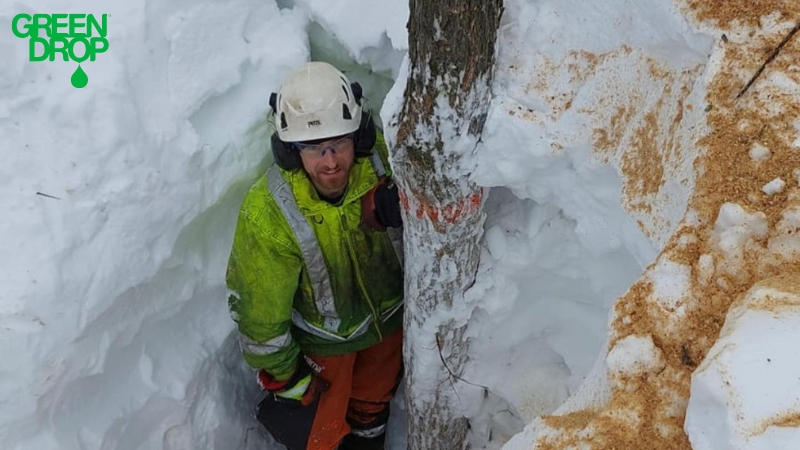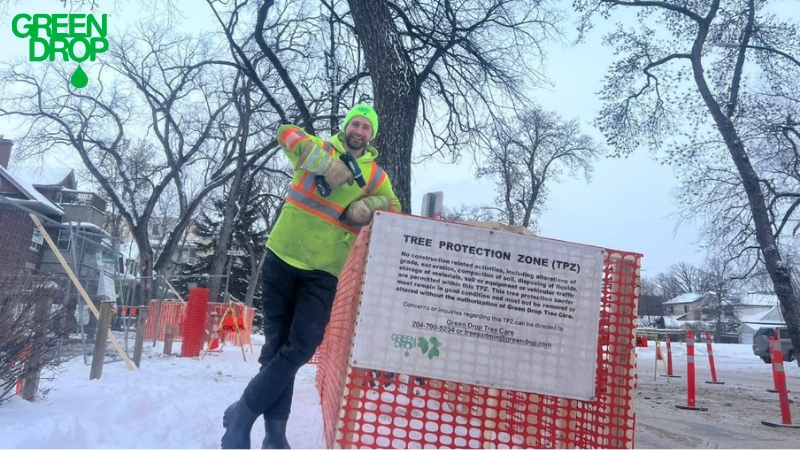Winter Tree Checklist for Winnipeg
Reading time: 7 minutesBefore you know it, winter’s going to be here. It’s that time of year when we all wish we could hibernate like bears. And, while we’re inside sipping hot cocoa and maybe complaining a bit about the frosty temperatures, your trees are out there braving the elements.
Your trees don’t get the luxury of snuggling up under a blanket. They have to stand guard over your frozen yards, watching their own backs against those icy winds.
So, before you settle in to binge-watch your favourite series this winter, let’s make sure your leafy friends are ready to face the chilly season head-on. They don't get snow days, after all!
November: Prepping for Winter

We’ll probably see the first snow at the end of October and the start of November. This is your cue to begin preparations, so your trees are ready before winter sets in. Here’s your pre-winter playbook against the impending frost:
- Inspection and Assessment: Give each tree a good once-over. This is your last window to catch any diseases, damage, or structural concerns before your trees are covered in snow. Look for cracks, weak branches, and signs of disease or pest infestation that could worsen under the weight of snow and ice.
- Mulching: Mulch in winter is pretty much like a cozy blanket for your tree’s roots. A nice layer of mulch (2–4 inches) acts as an insulation layer, keeping the soil around the roots warmer and more temperature-stable as the mercury drops. Spread a generous layer around the base of your trees, but don’t let it touch the trunk directly. Keep it a few inches away to prevent moisture accumulation and rot.
- Thorough Watering: Water your evergreen trees well before the ground turns into a winter wonderland of ice. This may be in October or November. Check the forecast for the first snow and plan your last watering before that. This hydration boost will help them withstand the dry, harsh winter conditions.
Water deeply to encourage the roots to stretch down and strengthen, setting the stage for resilience against the freezing weather.
- Protection from Pests: As the cold sets in, pests start looking for cozy winter homes, and your trees look mighty inviting. In certain cases, it might be feasible to wrap tree trunks with protective materials to guard against rodents and deer that can cause damage. Also, consider environmentally friendly pest deterrents to keep smaller pests at bay without harming your trees or the surrounding ecosystem.
December, January, February: Winter Maintenance

OK, so we’re at the deep end here. It's a beautiful sight, no doubt, but it's also too cold to do much for your trees. However, you can take certain steps for winter tree care.
- Monitor Snow and Ice Coverage: Snow and ice can be picturesque, but too much accumulation can burden tree branches. Gently brush off snow from the limbs with a broom or use a soft rake to relieve the weight. For ice, it’s often safer to let it melt naturally, as trying to remove it can damage the brittle, frozen branches.
- Tree Wraps: Wrapping the trunk with a breathable material can provide a necessary shield to protect younger and thin-barked trees from frost cracks and sun-scald. The wrap reflects sunlight and insulates the trunk, maintaining a more consistent temperature throughout the day.
- Check for Damage: Regularly inspect your trees for signs of stress or damage from the cold. Look for cracks in the bark, signs of branch breakage, or any tilting that could indicate root issues. If you see something, call in our certified arborists, who will recommend the best course of action.
March/April: Planning for Spring
The worst of the cold has passed, and it’s time to prepare for early spring. Here’s what our game plan is:
- Assess Winter Damage: Look for broken branches, signs of disease that could have proliferated in the damp, and any structural weaknesses.
- Planning Pruning for Early Spring: Pruning in the late winter, just before spring, encourages fresh growth and helps trees heal quickly from any cuts. Trees like maples, oaks, and fruit trees can benefit from late winter / early spring pruning as it prevents the spread of disease and allows for clearer visibility of the tree’s structure. More on this later.
- Pre-Spring Fertilization: Aim to apply a balanced fertilizer as the ground begins to thaw but before new growth starts. This helps replenish essential nutrients that were depleted over the harsh winter months, giving your trees a boost to jumpstart their spring growth. This is vital for your trees that have exhibited signs of nutrient deficiencies or are located in urban areas where soil might be less than ideal.
- Resetting Mulch and Protection: Take a walk around your property to check if the mulch is still effectively covering the root zones without being washed away or compacted. Add more if you need to maintain a protective layer that will keep roots moist and insulated as temperatures start to rise. Also, check to see if the installed wraps or burlaps are secure and intact.
Should I Prune and Trim In Winter?

The answer is: it depends. Most of the time, you want to prune during the dormant season. This occurs between late fall and early spring or between November and March.
For many trees, pruning during winter might be ideal:
Why Prune in Winter?
We call late fall and winter the dormant season for trees. With the leaves gone, the structure of the tree is fully visible, making it easier to identify and remove any damaged or diseased branches. This clarity helps with more precise cuts.
Additionally, pruning during the colder months minimizes the risk of spreading diseases and attracting pests, which are less active in winter. The wounds from the cuts heal faster as the tree wakes up in the spring, bursting with energy to seal and regrow.
How to Prune in Winter?
When pruning in cold weather, caution is always needed. Always use sharp, clean pruning tools to make clean cuts that heal quickly. Avoid cutting too close to the trunk or leaving too large a stub, as both can affect the tree's natural healing process. Also, choose a mild, dry day for pruning. If you’re cutting during extreme cold, it could cause branches to become brittle and break unpredictably, potentially causing more damage.
Which Trees To Prune in Winters?
This is an excellent question. Not all trees need pruning in the winter, but many deciduous trees and certain conifers in Winnipeg respond well to being pruned during dormancy.
- Deciduous Trees: Many deciduous trees, such as oaks, maples, and elms, are well-suited to winter pruning. Pruning these trees during dormancy reduces the risk of transmitting diseases like Oak Wilt in oaks and Dutch Elm Disease in elms. The dormant season minimizes sap loss, which can attract pests that transmit these diseases.
- Conifers: Most conifers, with the exception of pines, also respond well to being pruned in late winter, just before the spring growth begins. This timing is crucial as it allows cuts to heal rapidly with the onset of new growth, reducing the risk of disease entry. Conifers like spruces and firs can be pruned to remove dead or diseased branches, which helps maintain their shape and overall health.
Note: Don’t prune pines in winter. Unlike other conifers, pines are best pruned in early summer after the new growth has formed 'candles' but before these candles have fully hardened. Pruning pines in winter can lead to excessive sap flow from the cuts, which can weaken the tree.

Spruce Things Up This Winter with Green Drop
Feeling a bit "out on a limb" about tackling tree care this winter? Don't worry, you're not alone. When it comes to pruning and trimming, it’s often a tall order to handle on your own. Green Drop’s team of ISA-certified arborists is here to save the day.
If you’re looking to make sure your trees are all spruced up for spring, get an estimate from Green Drop today. We handle everything from tree trimming to pruning, so you can rest easy knowing your trees are in good hands.
We’re in major cities across Western Canada, including Winnipeg, Red Deer, Calgary, Regina, Saskatoon, and Edmonton.

